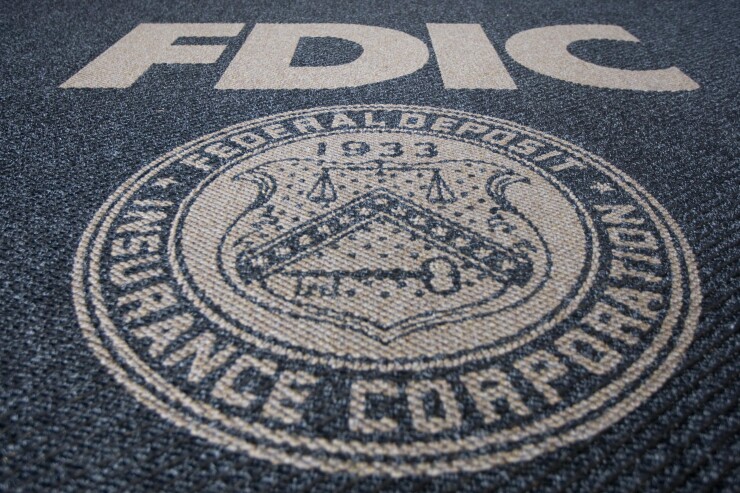Although the overall banking system's exposure to commercial real estate and leveraged lending is relatively stable, regulators are still on alert on both issues, according to a report released Monday by the Federal Deposit Insurance Corp.
The report, which tackled both areas separately, found that the preponderance of banks "remain satisfactorily rated" when it comes to CRE exposure. It noted that the industry's approach to managing risk in leveraged lending, meanwhile, has "improved significantly."
Still, regulators see areas of concern. For example, out of 470 supervisory activities FDIC examiners completed over two years, 24% of them featured CRE-related Matters Requiring Board Attention, regulatory parlance for issues that institutions need to address relatively quickly.

The most pressing areas highlighted ranged from management oversight to portfolio analysis, funding strategies and underwriting practices, according to the FDIC’s report.
The board- and management-level handing of CRE concentration was the chief concern of FDIC examiners, making up more than 56% of all the supervisory recommendations regulators made in the two-year period. Of those, 27% of the recommendations included matters requiring board attention.
“Supervisory recommendations and MRBA regarding oversight most commonly addressed inadequate establishment and monitoring of concentration limits and sub-limits, improvements needed in loan policy exception tracking and reporting, and concerns about strategic planning,” the report said.
Examiners appeared keen to address the risks of inadequate data monitoring of a bank’s own loans, writing that “untracked or poorly-tracked policy exceptions may lead to a credit culture and risk profile exceeding the risk tolerance established by the IDI’s board of directors.”
Regulators also also noted a pattern of some CRE strategic plans that relied on “unrealistic or not well-developed assumptions,” while other institutions “did not incorporate CRE lending considerations at all.”
In the realm of portfolio analysis, FDIC examiners noted that the industry had by and large made significant progress in recent years. But among institutions that had higher-than-average levels of CRE lending, 41% of supervisory actions involved portfolio-level sensitivity analysis, and 22% of those actions included an MRBA.
Beyond doing the analysis, however, examiners also noted instances where “management performed calculations but did not integrate results into the [bank]’s oversight and planning processes.”
The FDIC also made a point of highlighting shortcomings in funding strategies among its supervised banks. More than 28% of its reviews made supervisory recommendations based on how banks designed their funding strategies, and nearly half — over 45% — of those recommendations included an MRBA.
Examiners noted weaknesses in “the monitoring of funding sources supporting the CRE loan portfolio” and in monitoring banks’ sensitivity to liquidity.
The FDIC also pointed to the underwriting challenges of a concentrated CRE portfolio as an area of concern.
“The large majority of the FDIC-supervised IDIs reviewed have overall sound underwriting practices,” the report said, but examiners noted shortcomings in analyzing repayment capacity and calculating borrowers’ global cash flows.
Leveraged lending
Leveraged lending has been flagged recently by regulators as a potential worry, even though most have said any problems are not systemic.
In the report, the FDIC said that during the last five or so years, banks have become better at managing the risk from leveraged lending, particularly when it comes to underwriting. But “credit structures themselves have continued to weaken, reflecting heightened demand for leveraged credit and non-bank preferences on terms,” according to the report.
To be sure, a significant amount of leveraged lending now happens outside the banking sector — nearly 40% was held by non-banks at the end of 2018, according to the Shared National Credit Program — but some of that activity still hangs over the industry. "In order to satisfy investment demands, banks [have begun] to structure leveraged lending products that more closely resemble a bond than a corporate loan,” the FDIC report said.
In practice, that means fewer financial maintenance covenants with borrowers and minimal debt amortization, all of which introduces more risk to banks.
Regulators pointed to data from Moody’s Investors Service, which tracks the strength of the industry’s loan covenants by quarter. Since the fourth quarter of 2016, scores have remained weaker than the five-year average.
Moreover, as loan volume increases and credit structures weaken, evaluating capital, business assets and common stock has become an increasingly vital part of how banks structure their leveraged loans, all of which “results in valuing the company based on its ability to generate recurring cash flow.”
“The value of a company can rapidly fluctuate,” the report notes, and “examinations have identified instances in which [banks] failed to adequately monitor enterprise value, or where enterprise valuation methodologies were inadequate.”





